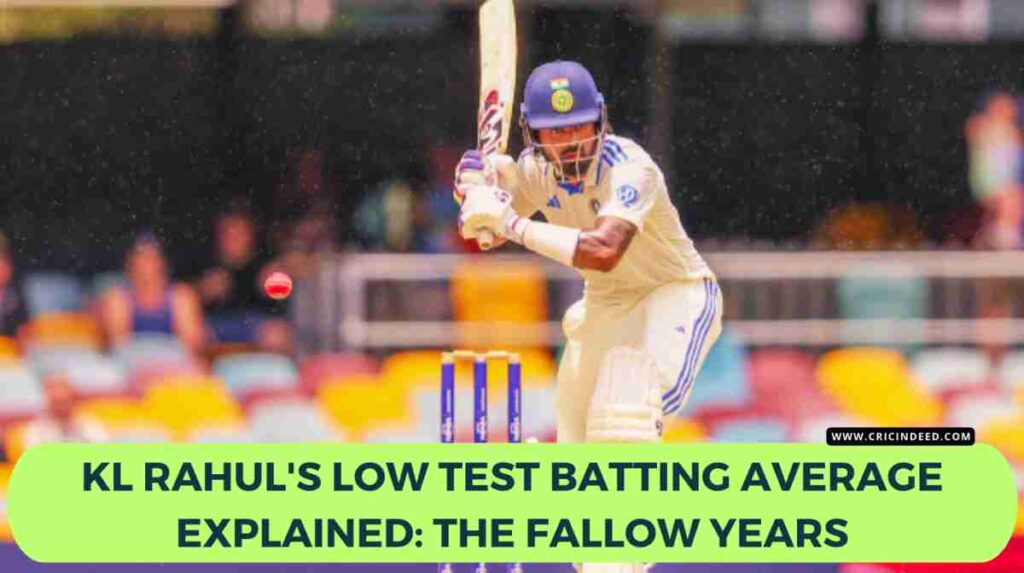KL Rahul has been part of Indian cricket for more than a decade now. Since his debut in 2014, he has played every role asked of him — opener, middle-order batter, wicketkeeper, even stand-in captain. He has featured in World Cups, led India in crunch situations, and filled gaps across formats whenever the team needed balance.
Yet, one number keeps haunting him: his Test batting average, which still hovers around 35.
The quick answer to why KL Rahul’s Test Batting Average is low (35.41) is a combination of inconsistent role definition, the mental burden of hyper-versatility, a six-year lean patch (2017-2023), and a historically poor conversion rate of half-centuries into large match-winning scores (only 10 centuries from over 25 fifties).
This number feels strange if you’ve watched Rahul bat. His technique is solid, his range is wide, and his temperament is calm. On the eye, he looks like a player made for Test cricket. But the stats never quite match the promise.
The Conversion Issue: Too Many Fifties, Too Few Hundreds
Rahul has more than 25 Test fifties, but only 10 centuries. And only two of those centuries have gone beyond 150. That shows he gets in, builds an innings, but doesn’t always finish the job. In Test cricket, the ability to turn a good start into a big hundred can transform averages. This is where someone like Virender Sehwag or AB de Villiers stood out, often pushing past 150 and lifting their career numbers. Rahul, on the other hand, has too many “what could have been” moments.
The Statistical Defense: KL Rahul’s Elite Overseas Average (The SENA Factor)
While his overall average is low, a statistical deep dive shows a mitigating factor: Rahul plays his best cricket in the toughest conditions.
A high percentage of his career tests have been in SENA (South Africa, England, New Zealand, Australia) countries. His average in these difficult conditions is often higher than his average at home, a rare feat for an Indian batsman. This high-class performance in high-pressure, low-scoring environments makes his overall average a deceptive metric of his ability. For a full breakdown of his performance across continents, see KL Rahul’s Test Runs in Each Country.
The Cost of Being Versatile & Overthinking
Rahul is one of the few players who look at ease across formats. He can attack at a strike rate of 200 in T20s, control an ODI chase, or block all day in Tests. But this flexibility comes at a price. In red-ball cricket, he sometimes looks stuck between approaches. Should he leave, defend, or attack? That split-second of doubt often proves costly. Where someone like Sehwag trusted his instincts, Rahul’s adaptability can sometimes turn into overthinking. The volatility in his performance is best seen when charting his Test runs year-by-year, which tells the story of his consistency issues.
No Permanent Home: The Weight of Unstable Selection
Another challenge has been his unsettled role. He has batted everywhere from the middle order to opening. Injuries, reshuffles, and team experiments have kept him moving around. Unlike Virat Kohli or Rohit Sharma, who found stable slots early, Rahul has always had to fight for his place. That uncertainty can weigh heavy on a batter’s mind. Despite this, he has still delivered in tough overseas tours, proving his class in England, South Africa, and Australia.
The Opener vs. Middle-Order Split
The constant shuffling is reflected in his career numbers. His average as a specialist opener (38.5) is significantly different from his average in the middle-order (30.1), indicating that the lack of role clarity is a key statistical drag. You can view the complete details of his Test runs by batting position here.
Old-School in a New Era
Rahul plays Test cricket the traditional way — patient, grinding, wearing bowlers down. That works on challenging pitches, which is why he has succeeded overseas. But modern Test cricket has shifted. Teams are chasing big targets, playing with intent, and putting pressure back on bowlers. Rahul hasn’t fully adapted to that shift, especially on flatter pitches where others score quickly.
Final Thoughts
None of this takes away from his ability. Rahul has produced match-winning knocks at some of the hardest venues in the world. He is a rare player who can fit into any role. But the average doesn’t reflect all that. It hides the instability of his role, the pressure of expectations, and the difficulty of converting starts into match-defining scores.
Review his detailed performance against every major opposition by viewing KL Rahul’s Test Runs vs. Each Team Stats.
At 33, Rahul still has time. With clarity in his role and less pressure to constantly prove himself, he could finally align his numbers with his talent. Because make no mistake — being KL Rahul has never been easy.

